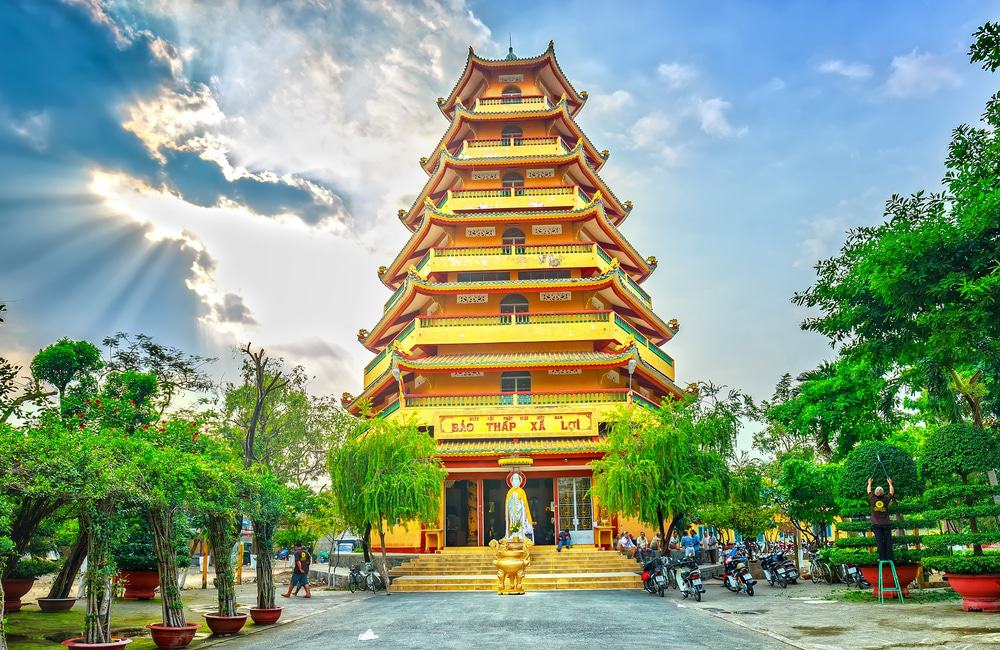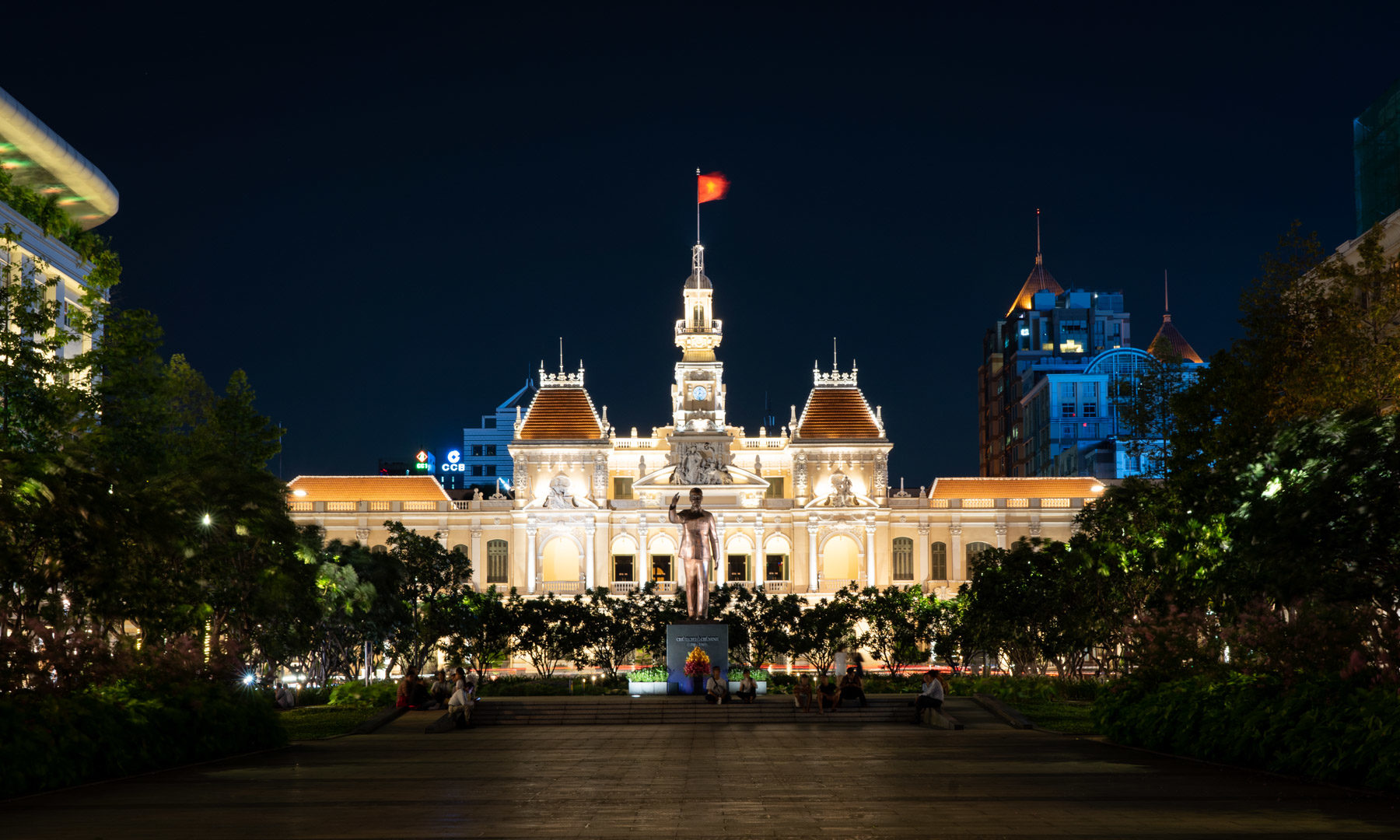
Ho Chi Minh City is a city that never seems to sleep. A thrumming, chaotic, and utterly captivating metropolis, it is the economic engine of Vietnam and a place where history and modernity clash on every corner. To some, it is still Saigon, a name that evokes images of a bygone era of French colonial elegance and wartime turmoil. To others, it is Ho Chi Minh City (HCMC), a symbol of a reunified nation hurtling towards the future. For the traveller, it is both.
This is a city of a million motorbikes flowing like a metallic river through streets shaded by tamarind trees. It’s a city where glistening skyscrapers cast shadows on ancient, incense-filled pagodas, and where the world’s finest street food is served on tiny plastic stools. To visit HCMC is to dive headfirst into a sensory whirlwind of sights, sounds, and smells. This guide will help you navigate its vibrant streets, understand its poignant past, and discover the soul of Vietnam’s electric heart.
A Glimpse into the Past: The History of Saigon

Related Articles about The Electric Heart of Vietnam: An Insider’s Guide to Ho Chi Minh City:
- Morocco: A Traveler’s Guide to the Kingdom of a Thousand Colors
- Vietnam: A Symphony of Sights, Sounds, and Stories – Your Ultimate Travel Guide
- Venice: A Timeless Travel Guide to the Floating City
- Lebanon: A Tapestry of Time, Taste, and Terracotta Dreams
- Ho Chi Minh City: A Symphony of Saigon’s Spirit – Your Ultimate Travel Guide
To truly appreciate HCMC, one must understand its layered history. Long before the French arrived, this area was a Khmer fishing village known as Prey Nokor. It wasn’t until the 17th century that it was settled by the Vietnamese and became Saigon. Its strategic location on the Saigon River made it a hub for trade and commerce.
The French colonial period, beginning in the mid-19th century, profoundly shaped the city’s identity. The French transformed Saigon into the "Pearl of the Orient," constructing wide, tree-lined boulevards, grand administrative buildings, and elegant villas. Much of this European-inspired architecture remains today, giving the city its unique East-meets-West aesthetic.
In the 20th century, Saigon became the capital of South Vietnam and the epicentre of the tumultuous Vietnam War (known in Vietnam as the American War). It was a city of journalists, spies, soldiers, and political intrigue. The fall of Saigon on April 30, 1975, marked the end of the war and the reunification of Vietnam. A year later, the city was officially renamed Ho Chi Minh City in honour of the revolutionary leader. Today, while HCMC is the official name, "Saigon" is still widely used, especially when referring to the historic central core, District 1.
Top Attractions: Where History and Modernity Collide
HCMC’s attractions are a compelling mix of historical reflection, cultural immersion, and modern marvels.
For the History Buff: Echoes of a Tumultuous Century
-
The War Remnants Museum: This is an essential, albeit harrowing, visit. The museum offers a powerful, unflinching look at the Vietnam War from a Vietnamese perspective. The outdoor courtyard displays captured American military hardware, including tanks, jets, and helicopters. Inside, the exhibits are filled with graphic photography and poignant displays detailing the brutal realities of the war and the devastating effects of chemical warfare like Agent Orange. It’s a sobering and deeply moving experience that provides crucial context for understanding modern Vietnam.

-
Reunification Palace (Independence Palace): Frozen in time since April 30, 1975, this palace is a fascinating time capsule. It was here that a North Vietnamese tank famously crashed through the gates, symbolizing the end of the war. You can tour the president’s living quarters, opulent reception rooms, and the eerie basement war command centre, complete with original maps, communication equipment, and secret tunnels. The 1960s architecture and preserved decor make it feel like stepping onto a film set.
-
Cu Chi Tunnels: Located about an hour and a half outside the city, this is one of Vietnam’s most popular attractions. This immense network of underground tunnels was used by Viet Cong soldiers as a base for operations, a hiding spot, and a supply route during the war. A visit includes a short film, a walk through the jungle to see hidden trapdoors and booby traps, and the chance to crawl through a section of the claustrophobic tunnels. It’s a powerful testament to the ingenuity and resilience of the Vietnamese people.
Colonial Grandeur and Cultural Landmarks
-
Notre Dame Cathedral Basilica of Saigon: A striking red-brick cathedral that feels plucked straight from provincial France, this landmark stands in the heart of the city. Built in the late 19th century, all its materials were imported from France. It serves as a reminder of the strong Catholic influence during the colonial era. (Note: The cathedral has been undergoing extensive renovation, so check its accessibility before visiting).
-
Saigon Central Post Office: Located directly opposite the cathedral, this is arguably the grandest post office in Southeast Asia. Designed by the firm of Gustave Eiffel, its magnificent interior features a high, arched ceiling, beautifully preserved wooden phone booths, and two enormous, hand-painted maps of historic Saigon and the surrounding region. It is still a fully functioning post office, so you can send a postcard home from this architectural gem.
-
Ben Thanh Market: The city’s most famous market is a bustling, chaotic, and utterly enthralling experience. By day, its aisles are packed with vendors selling everything from souvenirs, textiles, and coffee to fresh produce and butchered meat. It’s a fantastic place to practice your bargaining skills. By night, the indoor market closes, and the surrounding streets transform into a vibrant night market, with dozens of food stalls serving up sizzling seafood, hot pot, and local delicacies.
Modern Views and Spiritual Sanctuaries
-
Bitexco Financial Tower & Saigon Skydeck: For a breathtaking panoramic view of the sprawling city, head to the Saigon Skydeck on the 49th floor of this lotus-shaped skyscraper. It offers a 360-degree perspective of the Saigon River, the endless sea of rooftops, and the rapid development of the city. It’s particularly stunning at sunset as the city lights begin to twinkle to life.
-
Jade Emperor Pagoda (Phuoc Hai Tu): This atmospheric Taoist pagoda, built in the early 20th century, is a world away from the bustling streets outside. The air is thick with the sweet smell of incense, and the dimly lit halls are filled with intricate, and sometimes intimidating, statues of deities and heroes from Taoist lore. It’s a place of quiet devotion and a fascinating glimpse into local spiritual life.
Navigating the Urban Jungle: Transportation
Getting around HCMC is an adventure in itself.
-
Ride-Hailing Apps (Grab & Gojek): This is the easiest, cheapest, and most popular way to get around. Download the Grab or Gojek app on your phone. You can book a car or, for a true local experience, a motorbike taxi (known as a xe om). The fares are fixed and incredibly affordable, eliminating the need to bargain.
-
Taxis: Stick to reputable companies like Vinasun (white with green and red stripes) and Mai Linh (green). Always ensure the driver uses the meter.
-
Cyclos: These three-wheeled bicycle taxis are more of a tourist experience than a practical mode of transport. They offer a slow, open-air way to see the sights in District 1. Always agree on the price and duration firmly before you get in.
-
Walking: The city centre (District 1) is relatively walkable, but be prepared for the heat, humidity, and the challenge of crossing the street. The golden rule for crossing is to walk slowly and confidently at a steady pace, allowing the river of motorbikes to flow around you.
Where to Lay Your Head: Accommodation Options
HCMC offers a vast range of accommodation to suit every budget and style.
-
Luxury: District 1 is home to world-class five-star hotels like the Park Hyatt Saigon, The Reverie Saigon, and the historic Hotel Majestic, which offer impeccable service, rooftop pools, and stunning river views.
-
Mid-Range: You’ll find a wealth of excellent boutique hotels, stylish serviced apartments, and comfortable 3- and 4-star hotels in District 1 and the slightly quieter, more local-feeling District 3. These offer great value for money.
-
Budget: The Pham Ngu Lao area in District 1 is the city’s legendary backpacker hub. Here, you’ll find countless budget-friendly hostels, guesthouses, and cheap eats. It’s a lively, social area perfect for those looking to meet other travellers.
Planning Your Trip: Best Time to Visit
HCMC has a tropical climate with two distinct seasons.
- Dry Season (December to April): This is the best time to visit. The humidity is lower, rainfall is minimal, and temperatures are warm and pleasant, making it ideal for exploring the city on foot.
- Wet Season (May to November): This season is characterized by high heat, humidity, and daily downpours. However, the rain usually comes in short, intense bursts in the afternoon, leaving the rest of the day clear. This is the low season, so you may find better deals on flights and accommodation.
Essential Travel Tips for a Smooth Saigon Sojourn
- Embrace the Street Food: HCMC is a paradise for food lovers. Don’t be afraid to pull up a plastic stool at a street-side stall. Must-try dishes include pho (noodle soup), banh mi (Vietnamese baguette), com tam (broken rice), and bun thit nuong (grilled pork with noodles).
- Discover the Coffee Culture: Vietnam is the world’s second-largest coffee producer, and its coffee culture is legendary. Order a ca phe sua da (strong iced coffee with sweetened condensed milk) and watch the world go by from a local café.
- Stay Alert: Like any major city, be mindful of your belongings. Keep your phone and wallet secure, and be aware of your surroundings, especially in crowded areas, to avoid petty theft and snatch-and-grabs.
- Get a Local SIM Card: Staying connected is easy and cheap. Purchase a tourist SIM card at the airport upon arrival for instant data access.
- Mind the Dong: The currency is the Vietnamese Dong (VND), which comes in large denominations. It’s easy to feel like a millionaire, but pay close attention to the number of zeros to avoid overpaying.
Conclusion: A City That Stays With You
Ho Chi Minh City is more than just a destination; it’s an experience. It’s a city of profound contrasts—of resilience and optimism, of ancient traditions and relentless progress. It can be intense and overwhelming, but it is also a place of incredible warmth, energy, and flavour. Dive in, embrace the chaos, and let the electric, unforgettable spirit of Saigon capture your heart.





